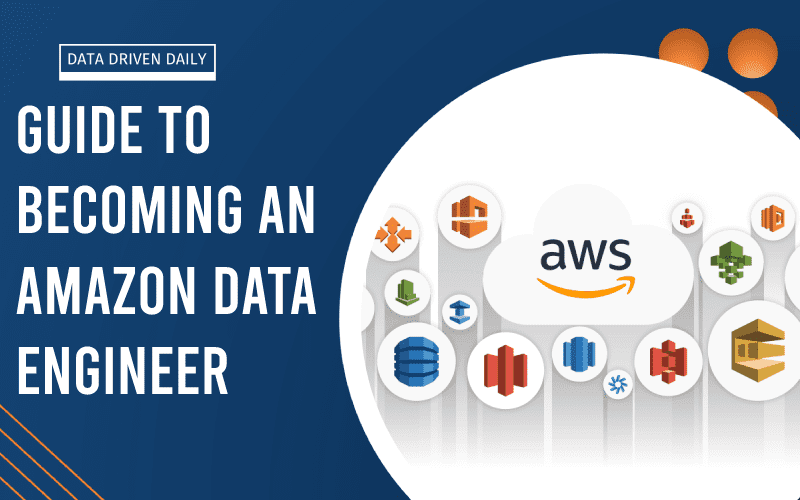Are you passionate about data?
Do you love working with large data sets, designing data models, and optimizing data pipelines?
If so, you might be interested in becoming an Amazon Data Engineer.
As one of the world’s leading e-commerce companies, Amazon relies heavily on data to drive its business. That’s why Amazon Data Engineers are in high demand. These talented professionals work on some of the most exciting data projects in the industry, and they play a crucial role in shaping the future of Amazon’s business.
So, how can you become an Amazon Data Engineer? In this article, we’ll explore everything you need to know to get started in this exciting and lucrative career.

What is an Amazon Data Engineer?
First, let’s start with the basics. What exactly does an Amazon Data Engineer do?
At a high level, Amazon Data Engineers are responsible for designing, building, and maintaining the data pipelines that power Amazon’s business. This includes everything from collecting and storing data to processing and analyzing it.
Amazon Data Engineers work with a variety of data technologies, including big data frameworks like Apache Hadoop and Spark, cloud-based storage services like Amazon S3, and distributed processing systems like Amazon EMR.
What Skills Do You Need to Become an Amazon Data Engineer?
If you’re interested in becoming an Amazon Data Engineer, you’ll need a mix of technical and analytical skills. Here are some of the key skills you’ll need to succeed in this role:
- Programming Skills: You’ll need to be comfortable working with programming languages like Python, Java, and SQL.
- Big Data Experience: You should have experience working with big data technologies like Hadoop and Spark.
- Data Modeling: You’ll need to be able to design and implement data models that are optimized for performance and scalability.
- Data Warehousing: You should be familiar with data warehousing concepts and technologies.
- Cloud Computing: You should have experience working with cloud computing platforms like Amazon Web Services (AWS).
- Analytical Skills: You should be able to analyze large data sets and draw insights from them.
How to Get Started as an Amazon Data Engineer
If you’re interested in becoming an Amazon Data Engineer, here are the steps you can take to get started:
- Get a Degree in Computer Science or a Related Field: A degree in computer science, data science, or a related field is a great way to get started in this career. You’ll learn the programming and analytical skills you need to succeed.
- Gain Experience with Big Data Technologies: Look for opportunities to gain experience with big data technologies like Hadoop and Spark. Consider taking online courses or participating in data science competitions to build your skills.
- Get Certified in Amazon Web Services: AWS is the cloud computing platform used by Amazon. Getting certified in AWS can help you stand out in the job market and demonstrate your skills to potential employers.
- Apply for Amazon Data Engineer Roles: Once you have the skills and experience, start applying for Amazon Data Engineer roles. Look for opportunities to work on exciting projects and make an impact on Amazon’s business.
Best Tools for Amazon Data Engineers
As an Amazon Data Engineer, you’ll need to work with a variety of tools and technologies to build, maintain, and optimize data pipelines. Here are some of the best tools for Amazon Data Engineers:
Apache Hadoop
Apache Hadoop is an open-source framework for distributed storage and processing of big data sets. It allows Amazon Data Engineers to store and process large amounts of data across clusters of computers. Hadoop is widely used in the industry and is a must-know technology for any data engineer.
Apache Spark
Apache Spark is another open-source big data processing framework that is gaining popularity among Amazon Data Engineers. It provides a faster and more flexible way to process data in memory and supports a variety of data sources and formats.
Amazon S3
Amazon S3 is a cloud-based object storage service that provides durable, scalable, and secure storage for data. It is used by Amazon Data Engineers to store and retrieve large amounts of data and can be integrated with other AWS services like EMR and Redshift.
Amazon EMR
Amazon EMR is a managed service that makes it easy to process big data using Hadoop, Spark, and other open-source technologies. It provides a fully managed, scalable, and secure environment for running big data workloads.
Amazon Redshift
Amazon Redshift is a cloud-based data warehousing service that allows Amazon Data Engineers to store and analyze large amounts of structured data. It provides fast query performance and can be integrated with other AWS services like S3 and EMR.
Apache Kafka
Apache Kafka is an open-source distributed streaming platform that allows Amazon Data Engineers to process real-time data streams. It provides a scalable and fault-tolerant platform for processing high volumes of data in real-time.
Airflow
Apache Airflow is an open-source platform for creating, scheduling, and monitoring workflows. It allows Amazon Data Engineers to create and manage complex data pipelines that involve multiple steps and dependencies.
Conclusion
Becoming an Amazon Data Engineer can be a rewarding and lucrative career choice. With the right mix of technical and analytical skills, you can play a crucial role in shaping the future of one of the world’s most innovative companies.
So, what are you waiting for? Start building your skills today and take the first step towards becoming an Amazon Data Engineer!
Ben is a full-time data leadership professional and a part-time blogger.
When he’s not writing articles for Data Driven Daily, Ben is a Head of Data Strategy at a large financial institution.
He has over 12 years’ experience in Banking and Financial Services, during which he has led large data engineering and business intelligence teams, managed cloud migration programs, and spearheaded regulatory change initiatives.